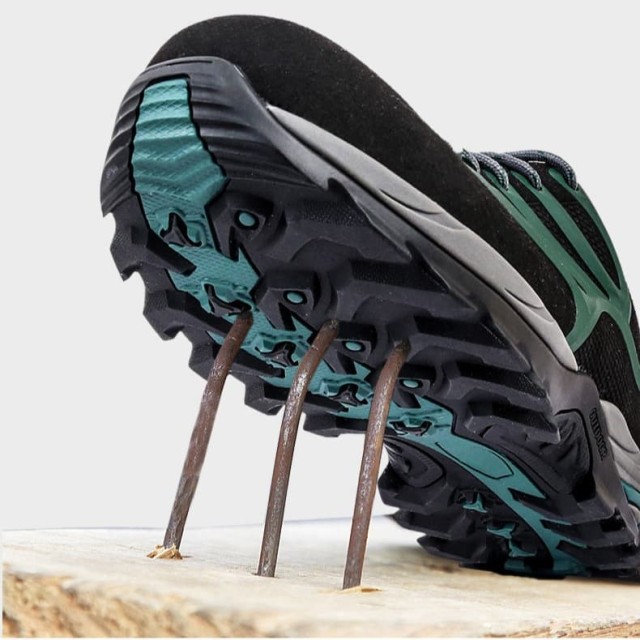Every year, thousands of workplace injuries occur due to punctures from stray nails, metal shards, and other sharp debris. For professionals in high-risk industries like construction, demolition, and manufacturing, the right footwear isn’t just about comfort—it’s a critical line of defense. This article breaks down the engineering behind penetration-resistant boots, the safety standards that validate their performance, and how to choose boots that genuinely protect.
The Hidden Dangers in High-Risk Industries
How Stray Nails and Metal Debris Cause Workplace Injuries
Sharp objects on worksites pose silent but severe threats. A nail protruding from a wooden beam or a fragment of shattered glass can easily penetrate standard work boots, leading to lacerations, infections, or even permanent nerve damage. Research shows that puncture-related injuries account for a significant percentage of foot injuries in industrial settings, many of which could be prevented with proper footwear.
Industry-Specific Risks: From Demolition to Glass Workshops
- Construction: Uneven terrain and discarded materials increase puncture risks.
- Demolition: Hidden nails and broken metal are common hazards.
- Glass/Sheet Metal Work: Sharp fragments litter floors, requiring boots with full-foot protection.
The takeaway? Not all work environments demand the same level of protection. Identifying your industry’s specific risks is the first step toward selecting the right boots.
The Science of Penetration Resistance
Steel, Kevlar, or Composite: Materials That Stop Sharps
Modern penetration-resistant boots use three primary materials, each with distinct advantages:
- Steel: The traditional choice, offering robust protection but adding weight.
- Kevlar: Lightweight and flexible, yet highly resistant to punctures. Ideal for workers needing agility.
- Composite (Carbon Fiber/Plastic): Lighter than steel and non-conductive, making them safer for electrical work.
Did you know? Some boots combine these materials—like a steel shank with a Kevlar midsole—to balance protection and comfort.
ASTM F2413 Explained: What "PR" Certification Really Means
The ASTM F2413 standard tests footwear for impact resistance, compression, and puncture protection. Boots labeled "PR" (Puncture Resistant) meet strict criteria:
- They must withstand a force equivalent to a 270-pound person stepping on a nail.
- The protective layer (often a steel or composite plate) must cover the entire sole.
Always verify the ASTM rating on product labels—this is your assurance of tested protection.
Beyond Basic Protection
Real-World Impact: Case Studies of Injury Prevention
- A demolition crew reported zero puncture injuries after switching to ASTM-rated boots, despite working on sites littered with rebar and nails.
- Glass manufacturers reduced foot-injury-related downtime by over 60% after mandating puncture-resistant footwear.
These examples underscore how the right boots don’t just protect; they also enhance productivity by minimizing accidents.
How to Verify Compliance When Buying Work Boots
- Check for Labels: Look for "ASTM F2413-11 PR" or similar certifications.
- Inspect the Midsole: Ask if the boot includes a full-length protective plate.
- Prioritize Fit: A poorly fitted boot compromises safety. Ensure ample toe room and arch support.
Have you considered how often your current boots are tested for wear and tear? Replacing them before the protective layers degrade is just as crucial as the initial purchase.
Final Thoughts: A Small Investment for Lifelong Safety
Penetration-resistant boots are more than PPE—they’re engineered solutions to invisible threats. By understanding materials, standards, and real-world performance, you can make informed choices that keep you safe without sacrificing comfort.
Ready to upgrade your team’s safety? Partner with 3515, a trusted manufacturer for distributors and bulk buyers, to source certified penetration-resistant boots tailored to your industry’s needs. From steel-toe designs to lightweight composites, we deliver footwear that meets the highest safety benchmarks—because every step should be a secure one.
Products You Might Be Looking For:
Explore certified penetration-resistant work boots
Related Products
- Durable Military Combat Boots with Water Drainage for Wholesale & OEM
- Durable Mid-Cut Tactical Boots for Wholesale & Private Label
- Wholesale Durable Mid-Cut Tactical Boots for Custom & Private Label Brands
- Factory-Direct Wholesale Canvas Boots with High-Traction Rubber Soles
- Wholesale High-Traction Camo Boots - Custom Manufacturer for Brands
Related Articles
- How Tactical Boots Deliver Long-Term Value: A Cost & Performance Breakdown
- How to Choose Tactical Boots That Match Your Law Enforcement Needs
- How Tactical Boots Solve Everyday Challenges: From City Streets to Job Sites
- How Tactical Boot Engineering Solves Real Outdoor Challenges
- How Tactical Boots Solve Real-World Challenges: From Work Sites to Wilderness



















